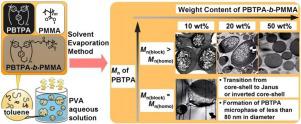Particuology ( IF 3.5 ) Pub Date : 2021-09-16 , DOI: 10.1016/j.partic.2021.09.002 Shu Kikuchi 1 , Ryoka Shoji 1 , Shinji Kanehashi 1, 2 , Guanghui Ma 1, 2, 3 , Kenji Ogino 1, 2

|
In order to mimic hierarchical nanostructures in nature, particles of polymer blends consisting of poly(4-butyltriphenylamine) (PBTPA), poly(methyl methacrylate) (PMMA) and PBTPA-block-PMMA were fabricated by a solvent evaporation method. Effects of the molecular weight and the chemical composition of PBTPA-b-PMMA, molecular weights of homopolymers, and the composition of the blend on the morphology were investigated. The polymer blend particle consisting of PBTPA and PMMA homopolymers exhibited thermodynamically favored core-shell structure, in which more hydrophilic PMMA-shell surrounded PBTPA-core. The addition of 10 wt% of PBTPA-b-PMMA caused the morphological transition from core-shell to Janus or inversed core-shell, in which PBTPA-shell surrounded PMMA-core, depending on the molecular weight of PBTPA segment in PBTPA-b-PMMA. When the molecular weight of PMMA segment was higher than that of PMMA homopolymer, watermelon-like particles in which small PBTPA domain less than 80 nm dispersed in the PMMA domain surrounded by PBTPA shell were observed. As the ratio of PBTPA-b-PMMA increased, the interface of the macrophase separation became obscure. At 50 wt% of the PBTPA-b-PMMA, only microphase separation was observed. The measurement of interfacial tension by pendant drop method demonstrated that PBTPA-b-PMMA lower the interfacial tension between PBTPA and the aqueous phase to the value similar to that of PMMA with the aqueous phase.
中文翻译:

在均聚物和嵌段共聚物三元共混颗粒中形成仿生分级纳米结构
为了模拟自然界中的分级纳米结构,由聚(4-丁基三苯胺)(PBTPA)、聚(甲基丙烯酸甲酯)(PMMA)和 PBTPA-嵌段-PMMA组成的聚合物共混物颗粒通过溶剂蒸发法制造。研究了 PBTPA- b- PMMA的分子量和化学组成、均聚物的分子量和共混物的组成对形态的影响。由 PBTPA 和 PMMA 均聚物组成的聚合物共混颗粒表现出热力学有利的核壳结构,其中更亲水的 PMMA 壳包围着 PBTPA 核。添加 10 wt% PBTPA- b-PMMA引起从核-壳到詹纳斯或反转的芯-壳形态的过渡,其中PBTPA-壳包围PMMA-核心,视PBTPA段的在PBTPA-分子量b -PMMA。当 PMMA 链段的分子量高于 PMMA 均聚物时,观察到西瓜状颗粒,其中小于 80 nm 的小 PBTPA 域分散在 PBTPA 壳包围的 PMMA 域中。随着 PBTPA- b- PMMA的比例增加,大相分离的界面变得模糊。在 50 wt% 的 PBTPA- b- PMMA 下,仅观察到微相分离。悬滴法测量界面张力表明 PBTPA- b-PMMA 将 PBTPA 和水相之间的界面张力降低到与 PMMA 与水相相似的值。


























 京公网安备 11010802027423号
京公网安备 11010802027423号